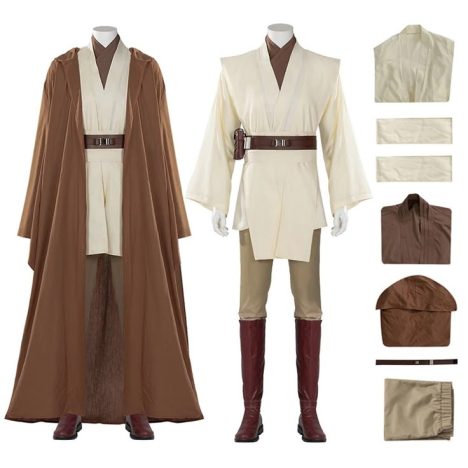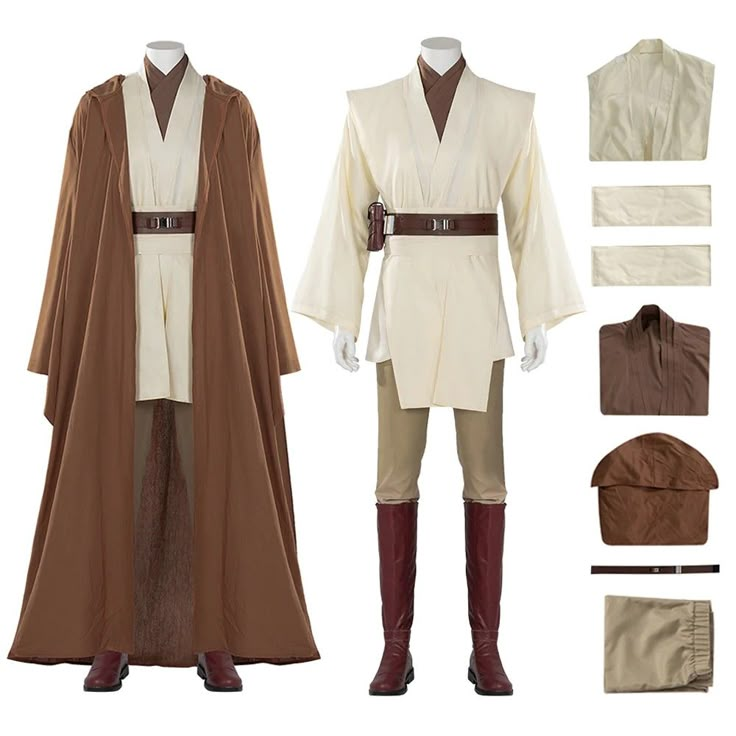Contents
- 1 The Origins
- 2 Essential Components
- 3 Selecting the Right Fabrics and Materials
- 4 Step-by-Step Guide to Making Your Jedi Robe
- 5 Customizing Your Costume: Belt, Boots, and Accessories
- 6 Sources for Jedi Costume Patterns and Tutorials
- 7 Tips on Getting the Details Right for Different Jedi Characters
- 8 Maintaining and Storing
The Origins
Understanding the origins of the Jedi costume helps you create an authentic look. The attire of Jedi, a group from the popular Star Wars universe, has a distinct appearance that blends traditional monk robes with a futuristic twist.
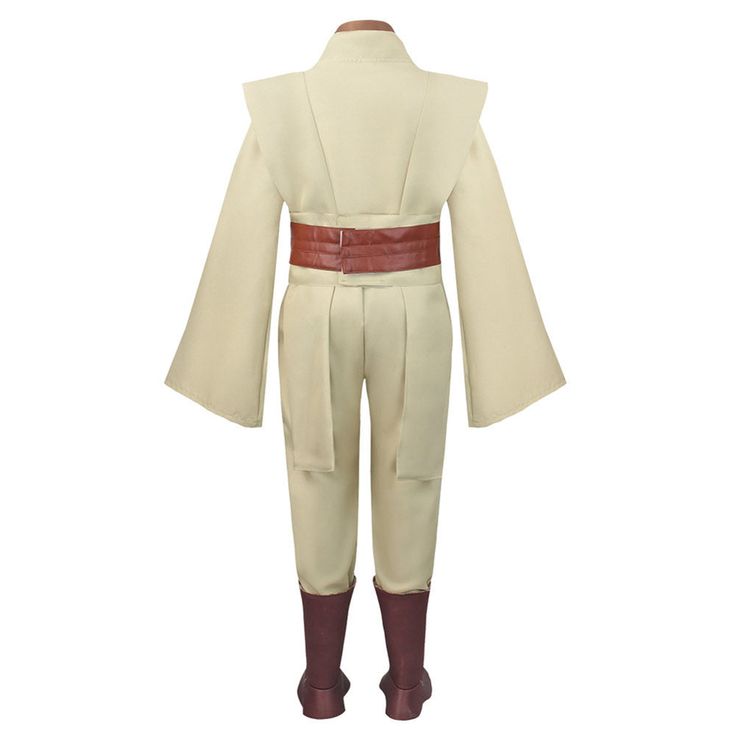
The Jedi costume first captures attention in the original Star Wars movies. The iconic design was a vision of director George Lucas, portraying a mix of samurai, medieval knights, and futuristic warriors. This blend symbolizes the Jedi’s role as peacekeepers with a deep connection to the Force.
Most notable is the Jedi’s simple robe. It echoes the humble and disciplined lifestyle of the Jedi Order. Colors are often earth tones, demonstrating their unity with nature and the Force. Light fabrics were chosen for the movies to allow freedom of movement, reflecting the agility and physical capability of a Jedi.
In creating your own Jedi costume, drawing from this rich history is key. It allows for a costume that’s not only visually striking but also true to the essence of what it means to be a Jedi. Use these insights as a foundation when selecting your fabrics and designing your costume.
Essential Components
Crafting an authentic Jedi costume involves attention to detail and a deep understanding of the character’s portrayal. Here is a breakdown of the components you’ll need to assemble your own Jedi ensemble:
- Robe: The centerpiece of the costume, typically in shades of brown or cream to reflect the earthy tones associated with the Jedi.
- Tunic: Worn under the robe, the tunic is usually lighter in color and can be long-sleeved or short-sleeved.
- Tabards: These are the strips of cloth that hang from the shoulders over the front and back of the tunic.
- Obi: A wide sash that wraps around the waist, holding the tunic in place and adding to the layered look.
- Pants: Simple, comfortable pants that allow for ease of movement, often matching the color of the tunic.
- Belt: A leather or simulated leather belt that features pouches for practicality and a spot to hang a lightsaber hilt.
- Boots: Knee-high boots, typically brown or black, that compliment the earthy tones of the entire ensemble.
These foundational pieces create the classic Jedi look. When selecting items for your jedi costume, make sure they fit comfortably and allow for a full range of motion. Jedi are known for their agility and combat skills, so your costume should not restrict movement. With these components, you’re well on your way to creating a Jedi costume that is both recognizable and true to the essence of the Star Wars universe.
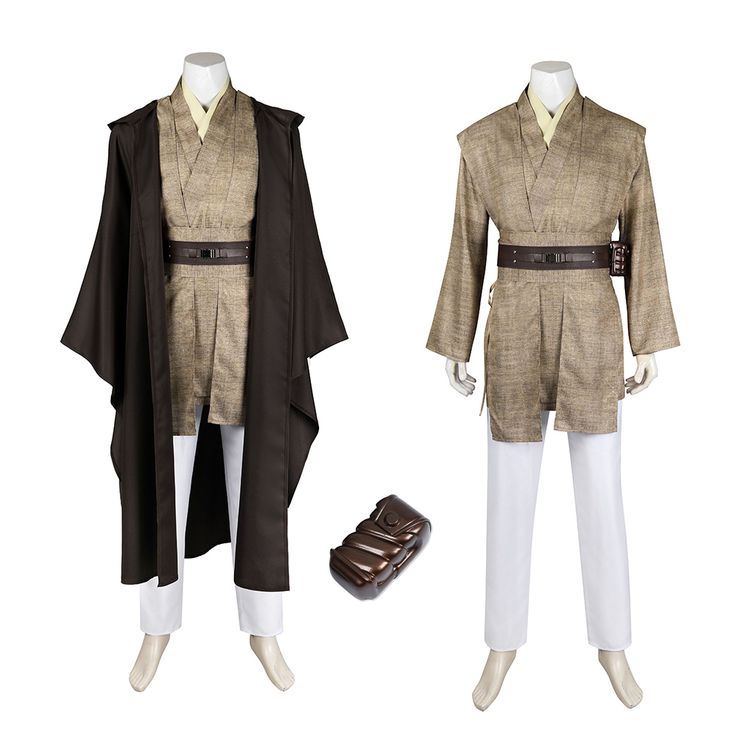
Selecting the Right Fabrics and Materials
Choosing the right fabrics and materials is crucial for your Jedi costume. The fabrics need to be lightweight yet resilient, to cope with dynamic movements. Linen and cotton are great choices for their breathability and natural look. These fabrics echo the humble origins and connection with nature of a Jedi. For the outer robe, consider a heavier fabric like wool or a wool blend to achieve that flowing, hefty appearance. For those on a budget, polyester blends can offer a similar look at a more affordable price. Just ensure the fabric’s drape matches the Jedi aesthetic.
When selecting materials for the belt and accessories, aim for faux leather or a similar synthetic that’s both durable and convincing. It should stand up to wear and tear without sacrificing the traditional look. Finally, opt for boots made of suede or faux leather. They should be comfortable for walking and flexible enough to allow free movement. By carefully selecting the right fabrics and materials, your Jedi costume will not only look authentic but also last through many adventures.
Step-by-Step Guide to Making Your Jedi Robe
Crafting your Jedi robe can be a rewarding project. Here’s a simple guide to help you start:
- Measure Yourself: Start by taking accurate measurements. You’ll need to know your height, arm length, and chest circumference.
- Choose Your Fabric: Select a heavyweight fabric for the robe. Earth-toned wool or a wool blend works well.
- Cut the Fabric: Lay out your fabric and cut it according to your measurements. Allow extra for hemming.
- Sew the Main Body: Sew the sides of the fabric to create the main shape of the robe. Remember to leave openings for the arms.
- Attach the Sleeves: Cut two pieces for the sleeves. Sew them to the arm openings you’ve left on the robe.
- Create the Hood: Measure and cut a large rectangle for the hood. Fold it in half and sew the back edge to create the hood’s shape.
- Attach the Hood: Sew the hood onto the neckline of the robe.
- Hem the Robe: Hem the sleeves, bottom, and front edges of the robe. This will give your Jedi robe a finished look.
- Add Fasteners: Optionally, you can add clasps or a button at the front to keep the robe closed.
By following these steps, you’ll have a Jedi robe that not only looks the part but also fits perfectly. Remember to give yourself time and patience as you work through each step. Your final product will be a testament to your skill and dedication to the Jedi Order.

Customizing Your Costume: Belt, Boots, and Accessories
After crafting the basics of your Jedi costume, it’s time to focus on the details. Customizing your belt, boots, and accessories will put the finishing touches on your look. Here’s how to make each element stand out.
- Belt: A Jedi’s belt is not just for show; it holds their tunic in place and carries essential items. Use faux leather to craft a sturdy belt. Add pouches and a clip for a lightsaber hilt. For a unique touch, customize the pouch shapes or add metallic detailing.
- Boots: Choose knee-high boots, preferably in brown or black. Suede or faux leather material will give you the traditional Jedi look. Make sure they fit snugly but leave room for comfortable movement.
- Accessories: This includes gloves, bracers, and a lightsaber hilt. Gloves should be of a matching material to the belt and boots. Bracers add to the warrior aspect and can be made from the same faux leather. Lastly, no Jedi costume is complete without a lightsaber hilt attached to the belt.
Remember that personalizing your costume is key. Think about the specific Jedi character you’re emulating and add details that align with their look. Whether it’s the rugged appeal of a seasoned Jedi or the sleek simplicity of a learner, your accessories should reflect that style. Paying close attention to these details can make your Jedi costume stand out in any crowd.
Sources for Jedi Costume Patterns and Tutorials
Finding reliable sources for Jedi costume patterns and tutorials can greatly simplify your costume-making process. Whether you’re crafting your first robe or looking to refine your existing costume, these resources are invaluable. Here’s where you can look:
- Online communities: Platforms like Reddit, Cosplay.com, and The Replica Prop Forum are treasure troves of information. Here, enthusiasts and experts alike share their own patterns and step-by-step guides.
- Dedicated fan sites: Some Star Wars fan sites offer specific guides and patterns for making Jedi costumes. They often provide detailed instructions catered to fans at different skill levels.
- Video tutorials: YouTube is an excellent source for visual learners. Seek out channels that focus on cosplay and costume-making for in-depth Jedi costume tutorials.
- Crafting websites: Websites like Instructables and Pinterest have a plethora of DIY guides, including those for Jedi costumes. You’ll find both text and visual aids to guide you through the process.
- Sewing pattern databases: Look for sewing patterns that can be adapted for Jedi costumes on sites like Simplicity or McCall’s. These commercial patterns can often be altered for a more personalized look.
Remember to check the reviews or comments on patterns and tutorials to ensure you’re getting top-notch advice. A well-reviewed pattern can save you time and reduce the likelihood of errors. Arm yourself with knowledge from these sources, and you’ll be well on your way to crafting an authentic Jedi costume.
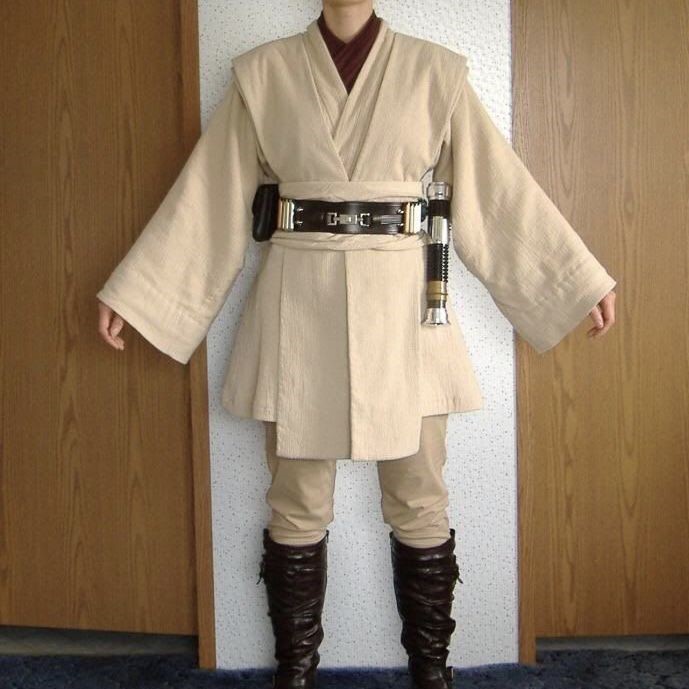
Tips on Getting the Details Right for Different Jedi Characters
Creating a Jedi costume that accurately represents a specific character involves more than just the basics. It requires a keen eye for the subtleties that make each Jedi unique. Here are tips to ensure you nail the details for your chosen character:
- Study Character Visuals: Reference official Star Wars media. Look closely at the character’s costume in movies, series, or books.
- Note Unique Features: Identify what sets your Jedi apart. It might be a distinct belt buckle, a robe color, or a special lightsaber hilt design.
- Imitate Fabric Textures: Different Jedis might have different fabric textures. Observe these closely and select your fabrics to match.
- Dye Fabrics for Accuracy: If you cannot find the perfect color, dye your materials. Get the shade as close to your reference as possible.
- Craft Custom Accents: Create unique accessories if they are not available to buy. Mold, sculpt, or sew these details to add authenticity.
- Weather Your Costume: Give it an aged look if portraying a battle-hardened character. This adds realism to your outfit.
- Maintain Character Stance: Mimic your character’s posture and movements. This brings life to the costume and enhances authenticity.
Remember that accuracy lies in the details. Your efforts to align as closely as possible with your character’s look will pay off, making your Jedi costume truly stand out at any event.
Maintaining and Storing
After putting time and effort into crafting your Jedi costume, it’s important to keep it in great condition for future events. Proper maintenance and storage are vital to prolonging the life of your costume. Here’s a straightforward guide to take care of your jedi costume:
Clean with Care
- Pre-storage Cleaning: Before putting your costume away, make sure to clean each piece thoroughly. This step helps remove any dirt, dust, or oils that may have accumulated during wear.
- Mild Detergents for Fabrics: Use mild detergents designed specifically for delicate fabrics when cleaning textile items. Avoid harsh chemicals that can cause fading or deterioration.
- Gentle Cleaning for Leather: For leather pieces, use a soft cloth to gently wipe down the surface. Consider using a specially formulated leather cleaner to maintain the material’s suppleness and shine.
Check for Repairs
- Inspect for Wear and Tear: Take the time to examine your costume closely for any signs of damage, such as tears, frayed edges, or loose threads. Early detection can save you from larger repairs later.
- Mend Small Rips: If you notice small rips, repair them as soon as possible to prevent the damage from worsening. Hand-sewing or using fabric glue can be effective for minor fixes.
- Secure Loose Threads: Tuck or sew down any loose threads to prevent further unraveling, which can lead to more significant issues over time.
Store in a Cool, Dry Place
- Avoid Humidity and Heat: High humidity and heat can cause fabrics to deteriorate. Always choose a storage location that maintains a stable, cool temperature.
- Ideal Environment: A closet or a dedicated storage area away from direct sunlight and heat sources (like radiators) is ideal for preserving your costume’s condition over time.
Use Breathable Covers
- Garment Bags for Fabrics: Store fabric items in breathable garment bags to protect them while allowing airflow. Avoid plastic covers, which can trap humidity and lead to mold or mildew growth.
- Protection for Leather Items: If you have leather pieces, consider using a cotton cloth to cover them. This keeps dust off while still allowing the material to breathe.
Keep Shapes Intact
- Using Padded Hangers: For robes and tunics, use padded hangers to maintain their shape and prevent creasing. Ensure the hangers are wide enough to support the weight without distorting the fabric.
- Storing Boots Properly: To keep your boots upright and maintain their structure, fill them with acid-free paper or clean socks. This method prevents them from collapsing and preserves their shape.
Avoid Light
- Protect Against Sunlight: Direct sunlight can significantly fade the colors of your costume over time. Always store your outfit in a place that is shielded from light to keep the hues vibrant.
- Dark Storage Areas: A dark closet or drawer is ideal for protecting fabrics. If you must use a garment bag or cover, choose a color that blocks out light.
Separate Components
- Storing Pieces Separately: When possible, store individual components of your costume separately. This practice minimizes the risk of color transfer, particularly with costumes that feature vibrant colors or delicate fabrics.
- Stacking Order: When arranging your costume pieces, place heavier items at the bottom and lighter ones on top. This strategy prevents crushing and helps maintain the integrity of all components.
By following these steps, you will ensure your Jedi costume stays in prime condition. It’ll be ready for your next galactic adventure, cosplay event, or Halloween party without last-minute fixes. Taking the time to maintain and store your costume correctly will save you time and effort in the long run.
